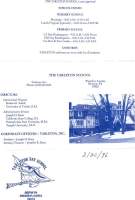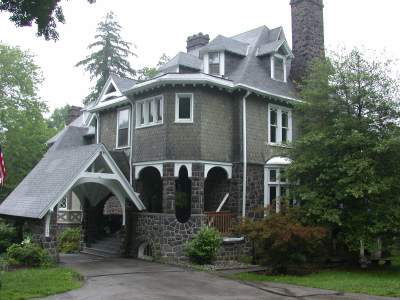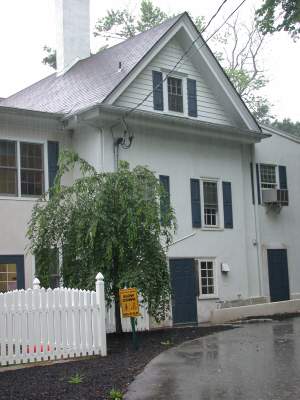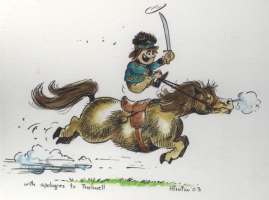


| [ Previous ] [ Next ] |

|
Originally, I had tucked this article into my "Trivia" page, but I've acquired some photos to share so I'm expanding it into a page of its own. The background information is somewhat sketchy and disjointed because when I set out to dig up a few paragraphs of fill-in, I discovered a dozen sources, and a few large holes.
There is a town named Tarleton in England, and Banastre Streets (with various spellings) both there and in nearby Liverpool, all relating to Banastre Tarleton's family. But who would have thought Ban's name would end up on an American nursery school? I received the following snippet from John G. Tarleton:
 [expand] |
Attached is a scan of literature I obtained at "The Tarleton School" in [Berwyn] PA. I happened on this school in my travels in February 1996 and had to stop in. It turns out that the name derives from the fact that the original portion of the building was the residence of Banastre Tarleton when he was in Philadelphia during the occupation.
It is extremely unlikely that the building was ever Tarleton's "residence," since Berwyn is situated only a few miles from Valley Forge. (Tarleton had chutzpah aplenty, but there are limits.) Another bit of information on Tarleton's quarters in Philadelphia -- written in 1836 and more plausible -- states that while Sir William Howe's army wintered in Philadelphia (1777-1778), Brigade-Major Tarleton took possession of the upper front rooms in the house then occupied by William Sitgreaves in Market near Third Street. It is possible, of course, that Tarleton spent a night in (future) Berwyn during a foraging raid, but I expect there has simply been a misunderstanding somewhere along the chain of communication.1
According to another snippet of Berwyn lore (obtained from the county's website), the school did, indeed, get its name from Banastre Tarleton, not because he stayed there but from "the Tarleton skirmish of 1777, following the Battle of Brandywine" which
was the most famous historical event [in the area]. Americans under the command of General Anthony Wayne, an Easttown native, and led by Captain "Light Horse Harry" Lee repelled an attack by the British on Signal Hill near the intersection of Newtown and Sugartown Roads. The house was later named Tarleton for the British leader."2
While this snippet opens up a curious question of why it didn't end up named the "Harry Lee Day School" if Harry won the fight, it definitely matches the location of the school -- although the time frame given ("following... Brandywine") causes some head-scratching. Every other piece of information I've located places the incident in mid/late January, 1778, which is certainly after Brandywine (September, 1777), but by several months and with no obvious connection between the two.

|
Anyway, I'll get to all that in a minute...
During a visit to Philadelphia in June, 2003, Holley and I dropped in on the Tarleton Day School, and were lucky enough to encounter staff members Dr. Joseph Kane and Barbara Smith who have an active interest in local history. They told us that the present building, a gorgeous, 19th century structure, is neither the site of the "Tarleton skirmish" nor the original location of the school. It was purchased some years ago by Dr. Kane, as an upgrade to the facilities. |
| The building where the school started out, and where Lee and his men are said to have holed up, is a short distance away, on Sugartown Road, about a mile south of the old Lancaster to Philadelphia road. Only the central portion of the present structure -- the section that sticks out a few feet -- must have existed at the time. In the intervening years, the building has more than doubled in size. |

|
The folks at the Tarleton Day School kindly copied for us an article from a local historical magazine, the Tredyffrin Easttown History Club Quarterly, which contains a lengthy discussion of the Tarleton/Lee skirmish. It describes the event as taking place at "Signal Hill in Easttown Township, on January 18, 1778." Signal Hill was one of a chain of guard outposts which formed an early warning system encircling Valley Forge. (When we dropped around, we saw the stump of the "signal tree" which once stood in front of the building.) At the time, the buildings consisted of a stone house and a barn that was used as a supply depot.
According to the Quarterly article, which is based on "an old account by Julius F. Sasche," Howe dispatched a force of 200 dragoons, under (ahem) "Colonel" Tarleton to eliminate Lee's pesky command, which was causing a problem with their supply lines. They captured some of the detachment who were out foraging, but had less luck taking Lee's command post. He and his men barricaded themselves in the house and successfully held off the attack, until reinforcements arrived or at least until the British thought they were about to. At one point, it is reported, "Colonel Tarleton was within point blank range of the carbine of Private O'Neil, only to be saved by a misfire and 'flash in the pan.'"3
By now many readers will have recognized that the article is describing the Lee skirmish which is commonly said to have taken place at "Spread Eagle Tavern." Bass recounts a typical modern version of that story which begins:
Learning that Captain Harry Lee was quartered in the Spread Eagle Tavern, about six miles from Valley Forge, Sir William Erskine, commander of the British cavalry, determined to capture him. Taking 200 light dragoons on the night of January 20, 1778, a party which undoubtedly included Lieutenant Colonels Harcourt and Birch as well as Captain Tarleton, Sir William followed a circuitous route for twenty miles and swept down on the Spread Eagle at daybreak.
Captain Lee and his few men barricaded the doors of the stone house and began firing through the windows.4
I was familiar with the incident, but had not known the precise location of the tavern, nor whether it still existed. So I went off to do a little digging, to confirm that the building on Sugartown road had been the Spread Eagle Tavern before it became the original Tarleton Day School. Unfortunately, I still don't have a definitive answer. As with most everything concerning Tarleton, there are multiple stories, and none of them ever exactly mesh.
One of the earliest accounts of the skirmish comes from the rebel press. On January 28, 1778, the New Jersey Gazette gushed:
 Having a somewhat warped sense of humor, I must admit a comment on the school's brochure that "Tarleton uniforms are worn daily by all students" conjures up a simply fascinating image. All those little kidlets in green jackets, nankeen breeches, miniature fluffy helmets.... No? Ah, well. At least it makes for a good Dragoontoon. |
JANUARY 21. -- Captain Lee, who has for some time past been posted at Valley Forge with his troops, has added another cubit to his fame. General Howe, longing to rob the Americans of this gallant young officer, whose attention in observing his motions, and address in surprising his parties perplexed him so much the last campaign, detached a large body of horse (said to be two hundred) to surprise him yesterday morning. By the assistance of a guide, who conducted them through by-roads, they avoided the videts, and surrounded the house where Captain Lee lay so suddenly that he had scarcely time to bolt the doors before they began a smart firing into the windows, and demanded the immediate surrender of the house. Major Jemmason, (of the same regiment with Captain Lee, and who lodged with him that night,) Lieutenant Lindsay, and five private troopers, were all that were with Lee at that time; the rest of the troops being quartered in a neighboring house. They returned the fire from the windows with spirit; and; by showing themselves at different places, made as great an appearance of numbers as possible. The enemy, after firing and threatening about twenty-five minutes, finding so gallant and determined a resistance, and having several of their men badly wounded, gave over their attempt and rode off full speed for Philadelphia. They made prisoners of four of the troop who happened to be out of the house when they surrounded it, and Major Jemmason and Lieutenant Lindsay were both slightly wounded. Thus this handful of brave officers and men, "by their infinite address and gallantry," repulsed a formidable body of horse sent on purpose to take them.5
And on the other side of the fence, Hessian officer Johann Ewald noted it in his diary entry for January 23, 1778:
Today the English Major Crewe was sent out with eighty horsemen to surprise the partisan Captain Lee, who stood with forty horse on this side of Valley Forge and constantly alarmed our outposts. The English dragoons had been guided so well that the Americans did not become aware of them until their vedettes opened fire. A part of the Americans on horse approached but were overthrown. Another part, with Captain Lee, threw themselves into a stone building and defended it so courageously that the English had to retire unsuccessful.6
While they disagree on the exact date of the skirmish and the size of the British cavalry detachment, the reports actually mesh to a surprising extent. Ewald is presumably wrong on the date, since Washington mentions the incident in both his General Orders and a private letter to Lee, dated January 20 -- but he is probably right on the size of the detachment. Neither report mentions a Spread Eagle Tavern, nor, for that matter, Banastre Tarleton's presence at the skirmish. But George Hanger, in a footnote to his Address to the Army, places Tarleton at the scene:
Tarleton distinguished himself on many services in the Jersies and Pennsylvania; particularly in the attack on a stone house, commanded by Colonel Lee, and miraculously escaped with his life, having his horse wounded in three places, his helmet shot off his head, and shot through his light dragoon jacket.7
Digging forward a bit through time, John Marshall's Life of Washington (1804) provides an account which is largely unchanged from the original newspaper story:
[Howe] confined his operations to those small excursions that were calculated to enlarge the comforts of his own soldiers, who, notwithstanding the favourable dispositions of the neighbouring country, were much distressed for fuel, and often in great want of forage and fresh provisions. The vigilance of the parties on the lines, especially on the south side of the Schuylkill, intercepted a large portion of the supplies intended for the Philadelphia market; and corporal punishment was frequently inflicted on those who were detected in attempting this infraction of the laws. [Read: farmers caught by the rebels were in danger of getting lynched] As Captain Lee was particularly active, a plan was formed, late in January, to surprise and capture him in his quarters. An extensive circuit was made by a large body of cavalry, who seized four of his patrols without communicating an alarm. About break of day the British horse appeared; upon which Captain Lee placed his troopers that were in the house, at the doors and windows, who behaved so gallantly as to repulse the assailants without losing a horse or man.8
The location is still a house, not a tavern (and there are still far too many dragoons on the loose.) In fact, the earliest mention I have been able to find of the Spread Eagle Tavern comes from Alexander Garden (1822):
When surprised at the Spread Eagle Tavern, near Philadelphia, and surrounded by the entire British cavalry, he assured the dragoons under his command, who gallantly joined in defending the house, that he should consider their future establishment in life, as his peculiar care; and he honourably kept his word.9
Garden served in Lee's Legion, and Harry's treatment of his troops was, apparently, of more interest to him than the details of the skirmish itself. In fact, there isn't enough detail to be sure that Garden is even describing the same incident, though it seems a reasonable assumption, unless the British cavalry spent the whole winter chasing Harry Lee around the countryside with periodic sieges and shootouts. Well, who knows? Maybe they did. The editor of Ewald's diary stuck in a footnote about the entry, guessing that it refers to a different skirmish entirely: "This affair," he says, "may have been the British attack on Virginia troopers in the house and barn of Andrew Wood of Roxborough during the winter of 1778. The incident is commemorated on a stone obelisk in Leverington Cemetery in Roxborough, Philadelphia."10
Anyway, I don't think I need to go haring off after that one. In the biographical note prepended to his father's Memoirs of the War in the Southern Department of the United States, Charles Carter Lee glues Marshall's account and Garden's snippet together, referencing both sources and pronouncing them a single event. From there forward, the skirmish became "Lee vs. the British cavalry at Spread Eagle Tavern" to most writers. Boatner references it as such, describing the location as "5 mi. S and slightly E of Valley Forge." He likely got that description from Freeman's biography of Washington (1951), which uses the same words, and also refers to "a fine defence by Capt. Henry Lee of the Spread Eagle Tavern."11
Other modern writers refer to the locale as "Scott's Farm," which meshes with contemporary references to the building as a "stone house" accompanied by a nearby barn. This seems a more likely identification.12
Diane P. Rofini of the Chester County Historical Society has kindly added a couple more snippet of information to the chronology, by checking historical maps of the area. She, too, has been unable to find any mention of a Spread Eagle Tavern, but tells me that
Both the 1873 and 1883 maps for Easttown show no building near the corner of Newtown and Sugartown Roads. ... The 1912 Mueller atlas shows "Signal Hill", a 12-acre property owned by Wm. T. Hunter at the SE corner of Newtown and Sugartown, while the adjoining property, 26 acres, at the SW corner of Sugartown and Church Rd., belongs to Nathan Trotter and is named "Tarlton Lodge."
The lack of buildings on the older maps adds an extra little puzzle, but the rest seems to fit.
With the information I have been able to find to date, it seems probable that Garden introduced an erroneous connection between the skirmish and the Spread Eagle Tavern, perhaps mis-remembering tales told to him by comrades in Lee's Legion some forty years earlier. There was a Spread Eagle Tavern near Valley Forge, active during the Revolution, but it was (and is) a few miles distant from the location of the skirmish, in Trumbauersville, PA. It could have been the site of other action, or a fondly remembered stopover point that got mangled in through fading memory. In fact, as I've discovered, the name was very common. There is a second surviving Spread Eagle in Pennsylvania, though it is some distance away and probably of slightly later period. It isn't impossible that there was a third, even closer to the school and now gone, though so far I have found no solid evidence of this.
I'd still like to know exactly why and when the building ended up acquiring Tarleton's name, rather than Lee's -- or even Crewe's, since he was apparently in command of the British detachment, with Tarleton along as a junior officer. (I can't help but wonder if Tarleton ended up out in front, in Private O'Neil's gunsight and getting his helmet shot off, due to his own impulsive nature or Crewe's orders. At some point over the winter, as reported by the London Political Magazine, young Cornet Tarleton had gotten himself "fairly caught in bed with Major Crewe's mistress," and the two men had come close to fighting a duel. I imagine Crewe would not have been too heartbroken to have gone back to Philadelphia minus one irritating junior officer.)13
I'm still chasing documents to fill in the holes, trying to find out why the local Historical Society talks about a skirmish "after Brandywine" (which implies something earlier than January, 1778) and so on. If anyone has more information to share, I'd be happy to have it.
[Many thanks as always to Don Gara for the info on Tarleton's Philadelphia address, John Tarleton for the heads-up on the school's existence, Dr. Kane and Barbara Smith of the Tarleton Day School for their help and hospitality, Holley Calmes for trekking around Philadelphia RevWar sites with me and making phone calls, Thomas Edsall and Christina Georgiou for chasing down leads, and Diane Rofini of the Chester County Historical Society for additional snippets.]
| [ Index ] | [ Previous ] [ Next ] |
1 Jacob Mordecai, "Addenda to Watson's Annals of Philadelphia: Notes by Jacob Mordecai, 1836," ed. Whitfield J. Bell, Jr., The Pennsylvania Magazine of History and Biography, 98 (1974): 165. [ back ]
2 From an online article on Easttown PA history, posted at www.easttown.org/history.htm, accessed June, 2003. [ back ]
3 "Who but a Fool Ever Threatened to Burn a Stone House?" Tredyffrin Easttown History Club Quarterly 17 (1): 3-6, O'Neil quote, p4. [ back ]
4 Robert D. Bass, The Green Dragoon; The Lives of Banastre Tarleton and Mary Robinson (New York: Henry Holt and Company; 1957), p38. [ back ]
5 Frank Moore, ed., Diary of the American Revolution from Newspapers and Original Documents, 2 vols. (New York: Charles Scribner; 1858), 2:10. [ back ]
6 Johann von Ewald, Diary of the American War: A Hessian Journal (Yale University Press, 1979), p121. [ back ]
7 George Hanger, An Address to the Army; in Reply to Strictures, by Roderick M'Kenzie, (Late Lieutenant in the 71st Regiment) on Tarleton's History of The Campaigns of 1780 and 1781 (London: James Ridgway, 1789), p88n. [ back ]
8 John Marshall, The Life of George Washington, Commander In Chief Of The American Forces, During The War Which Established The Independence Of His Country, And First President Of The United States...., 5 vols, (Philadelphia, 1804), 3:377-378. [ back ]
9 Alexander Garden, Anecdotes of the Revolutionary War in America, with Sketches of Character of Persons the Most Distinguished, in the Southern States, for Civil and Military Services (1822, Spartanburg, S.C.: The Reprint Company, 1972), p67. [ back ]
11 Mark M. Boatner III, Encyclopedia of the American Revolution (Mechanicsburg, PA: Stackpole Books, 1994), p608. Douglas Southall Freeman, George Washington, A Biography, 7 vols. (London: Eyre and Spotteswoode, 1951), 4:627. [ back ]
12 John W. Hartmann, The American Partisan: Henry Lee and the Struggle for Independence (Shippensburg, PA: Burd Street Press, 2000), p58. [ back ]
| Return to the Main Page | Last updated by the Webmaster on March 30, 2004 |